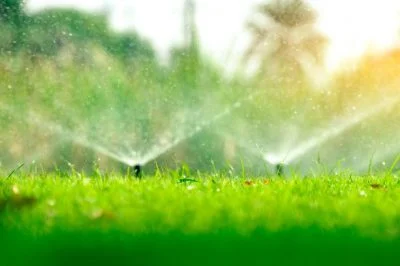How to Irrigate Your Lawn During the Summer Months

Everyone wants to have the best-looking lawn, especially in the summertime. Whether you’re a homeowner hosting backyard barbecues or a business owner serving customers, your property gets more attention this time of year when the days are longer and many flock to the great outdoors. How do you make sure your property looks its best throughout these hot, sunny days? Account Manager John Bland is here to share how irrigation can help your outdoor space stay healthy and attractive all summer long.
Aside from proper maintenance and fertilization, the one major factor to help set your lawn apart is proper irrigation. Spring rains help provide the necessary moisture that turf and plants need during the Spring growing season, but come July and August, we all wish mother nature would a give us a few rainy days here and there to give our landscapes some life again. If your property has an irrigation system, you don’t have to wish for rain and hope for the best. If you set your irrigation system properly, you can rest assured that your landscape will appreciate the extra water during those long drought periods. Here are a few simple tips to help properly set up your irrigation system for the growing season:
- What are You Trying to Irrigate?
Some types of turf and plants are more drought tolerant than others. While some turf and plants can go days or weeks at a time without moisture, others thrive off water and need it almost daily to survive. Determine the areas of your property that are irrigated and the portion of the landscape that is irrigated by each zone. Not all irrigation systems are alike, but it is best to irrigate turf and plant material separately. Having a general understanding of irrigation is key to having a thriving landscape during drought periods.
- How Long Do I Irrigate?
There is no set rule for how long irrigation should run. While there is information available on moisture requirements for turf and plants, moisture requirements can vary by geographic location, and other environmental factors in the landscape can have an effect on this as well. Generally speaking, the two most common types of irrigation heads are rotors and sprays. Rotors are commonly used to water turf areas and usually run for about 20-30 minutes during each cycle. Spray heads can be used for turf or plants and usually run for about 10-15 minutes per cycle. It is common for adjustments to be made to the run times depending on the weather patterns and how much moisture is being retained in the soil.
- When and How Often Do I Irrigate?
It is best to irrigate in the early morning hours when the temperatures are coolest and there is less humidity. This allows the water to be absorbed into the soil and taken up by the turf and plants. Depending on the size of the property, most irrigation systems run before daylight to give the moisture enough time to soak in and not be lost to evapotranspiration. Running irrigation during the middle of the day is ineffective, as a good portion of the water can be lost to the atmosphere before it is taken up by the plant. It is best to irrigate 2-3 times per week, but this can be modified based on temperatures and weather patterns. Deep and infrequent irrigation is key! This prevents plants from becoming solely dependent on water and it forces the plants to push their roots deeper into the ground in search of water. Watering too much and too often actually makes the plants dependent on water, leading them to develop shallow root systems.

























